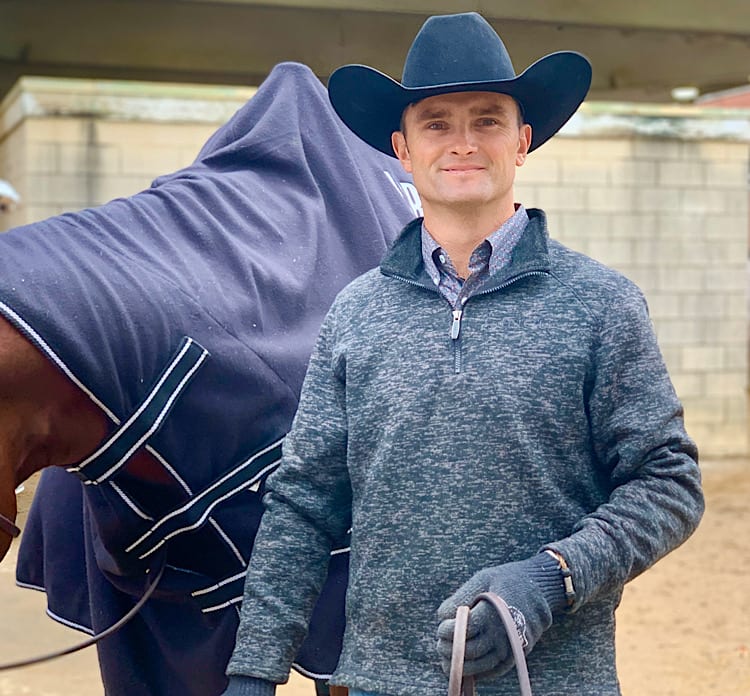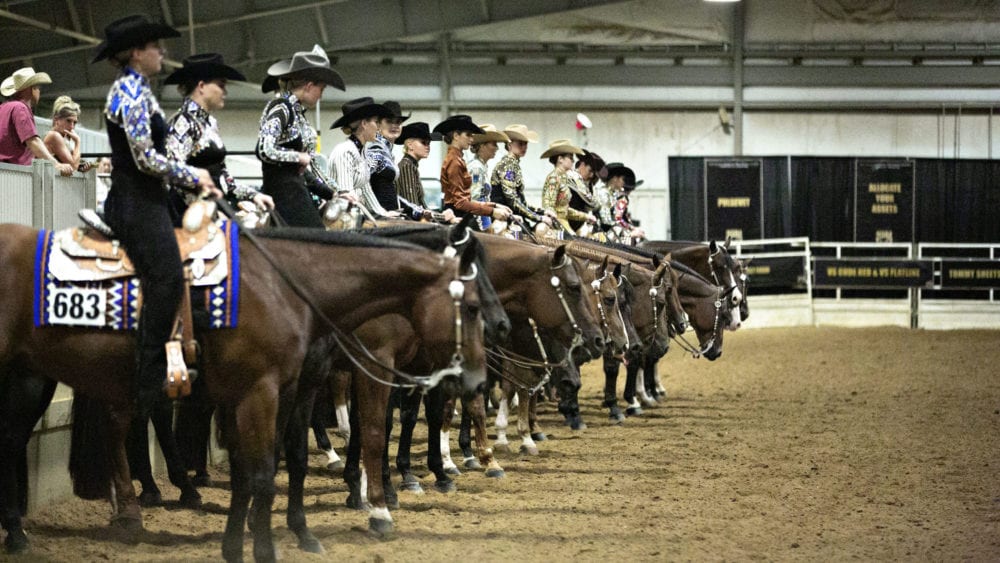Most of us are familiar with the TV show “MythBusters,” hosted by Adam Savage and Jamie Hyneman, two special effects experts who test the validity of certain myths and urban legends.
While these two professionals tackle the myths of the scientific world, GoHorseShow has compiled a group of equine professionals to bust the tall tales of the equine industry. Brad Kearns, Kelby Hutchinson, and Lynne Puthoff offered their expertise to help us create our own fascinating, educational, and much less explosive version of “MythBusters.”
Myth #1: If your horse is strong in the mouth, you need a stronger bit.
 Kelby Hutchinson (pictured right), of Hutchinson Performance Horses in Orrum, North Carolina, was quick to disprove this common misconception.
Kelby Hutchinson (pictured right), of Hutchinson Performance Horses in Orrum, North Carolina, was quick to disprove this common misconception.
“No. No, that’s a myth. A lot of times, especially with younger futurity horses, it’s not necessarily a stiffness through their mouth. Still, they need to use that to balance because they aren’t strong enough to carry a rider, or go slow, and do everything they need to do and carry it all on themselves. The crucial part of a horse’s balance is its neck, which then will translate through into the bridle. The fact is, if the horse is stiff in its face, the softer the bridle you use, the softer the horse you’ll have at the end of it,” he explained.
Myth #2: The trainer can fix any issue.
 “Sure! Absolutely… not,” Ohio trainer Lynne Puthoff (pictured left) joked, “the mythical, magical trainers can.”
“Sure! Absolutely… not,” Ohio trainer Lynne Puthoff (pictured left) joked, “the mythical, magical trainers can.”
Offering a more detailed explanation, AQHA Professional Horseman Brad Kearns said, “The trainer can fix some issues. A trainer can help to make your equine partner improve to the best of that horse’s ability and mental capacity. Your horse’s willingness to perform his or her duties directly affects how well he or she can learn to perform. While an unwilling horse can learn to become a better learner and perform better, the underlying issues that cause the unwillingness may never be fully resolved. Whether it is just not user friendly by nature, or maybe learned bad habits in its past, the animal may or may not learn to respond in the desired manner to get the treat at the end of the ride.”
“Just as a personal trainer can teach me the needed tools to improve my fitness and how to play basketball, a personal trainer can never teach me to play like Steph Curry. Similarly, a horse can only be taught to reach the heights of his or her conformation and athletic ability,” he finished.
Myth #3: Every horse will fit into every training program.
 “Definitely not,” Hutchinson told us, “It takes a special person to be able to get along with a lot of horses, let alone for any person to be able to get along with every horse. It just isn’t how it works.”
“Definitely not,” Hutchinson told us, “It takes a special person to be able to get along with a lot of horses, let alone for any person to be able to get along with every horse. It just isn’t how it works.”
But why, you might ask, is this the case? As Brad Kearns (pictured right) put it, “Horses are like people, and every horse learns differently and retains things differently.”
Puthoff built on this same idea, saying that “different trainers and different methods get along with different types of horses.” Whether it’s due to the “talent, their physical build, or the mentality of the horse,” she continued, specific programs work for some horses, but not for others.
Myth #4: A trainer can make any horse work for any rider.
While horseback riding is not a “team sport” in the traditional sense of the term, it requires an immense amount of teamwork nonetheless. Kearns put it this way, “A trainer can teach a horse the maneuvers much like teaching a person dance steps. In the end, the dance has two partners, and the team is only as good as the sum of its two individuals.”
For the “dance” to have the proper flow and elegance, the two individuals must balance one another. Puthoff explained that, just as every horse has different capabilities, both physically and mentally, “every rider has strong points and weak points. Are they a nervous type of person, or are they a calm type of person? Are they too strong, or are they too timid? Horses pick up on all of that.”
Finding the right partner is essential to achieving success in the show arena, but not every horse and rider will be the perfect match, and no trainer can fix that.
Myth #5: Effective hands are always bumping the bit.
Kelby Hutchinson debunked this myth, explaining that it is quite the opposite. “A good horse rider, whether it be professional, non-pro, or youth, should strive to have hands like a surgeon. Jay Starnes explained to me when I worked for him that the best hands can be as soft as butter, but can also really be firm when they need to be,” he said.
Puthoff agreed but clarified that, while the end goal is to, “get your horse to where it responds more to your leg and the feel of the reins,” finding this connection may require the rider to use, “some pulling and some bumping to get that horse to be lighter and be responsive,” to reach that goal. This does not mean that a rider should be bumping all the time, though. It is merely the “firm” hands that Hutchinson referenced, that will help the horse become more fine-tuned to a rider’s legs, seat, and soft feel of the reins.
Myth #6: When the horse is not giving you the intended response to a queue, asking the same way, only harder, will get you the desired response.
“If you ever saw Mad TV with Ms. Swan, then you know this myth is false,” Brad Kearns started. “The police ask Ms. Swan to describe a person who robbed her store repeatedly; her response is always, ‘he looked like a man.’ Same question, same response! If the desired response to a prompt by a rider is not achieved after multiple attempts, then the rider must reevaluate what the desired result is, and if they can break down the task into smaller tasks, that can then be put back together into the one end result,” he finished.
Altering how you are asking a horse to perform a particular task gives him the chance to process the information differently, and will often produce the desired response from the horse. Any great rider will understand that adjusting to the horse or slightly changing how they are queueing may be a necessary step in executing every maneuver with speed and accuracy.
Myth #7: Just because it can walk, trot, and lope, it’s going to be an excellent western pleasure horse.
When asked if there were any last horse training myths that he would like to see busted, Kelby Hutchinson immediately jumped to this one. “A lot of people think that western pleasure, in particular, is something that a horse just does overnight. Horses take a long time to do this and do this properly. There is so much more to it that people don’t realize without being around horses every day, that defines a great pleasure horse,” he explained.
Not every horse is destined to be a World Champion western pleasure horse, and that is okay. Having the patience to wait and trust your trainer or your training process is far more beneficial to the horse than forcing it into a job for which it is not suitable. The happiness of our horses (and the sanity of our trainers) should always be held to a higher standard than visions of golden trophies and neck sashes. You never know, just because a horse isn’t cut out for one event doesn’t mean that it will not succeed in another.
These are certainly only a sample of the countless myths that could be busted on the science of horse training. Though it may not have been as flammable or as gravity-defying as Adam Savage and Jamie Hyneman’s show, we hope that you found GoHorseShow’s special edition of “MythBusters” to be equally as educational and helpful in your riding endeavors. Are there any tall tales that you’ve heard during your time in the horse industry that we missed? Let us know.









